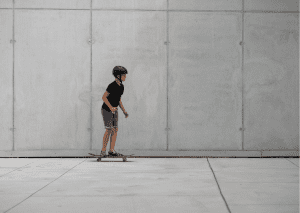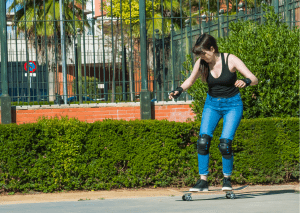Whether you’re a seasoned rider or just starting out, we all know that skateboarding is more than just rolling around on a board. It’s about mastering unique skateboarding skills, pushing your limits, and expressing yourself creatively.
So how can you take our game to the next level? Through structured practice and an understanding of essential techniques and ideas. This article has seen firsthand the transformative impact of effective practice on young rider’s abilities and confidence levels.
In this article, it will share essential guides and ideas to boost your game – from understanding your gear and parts like decks, wheels, and bearings, to mastering advanced stunts like kickflips and ollies.

It will also delve into strength conditioning exercises specifically for skateboarding, cover etiquette, and safety measures that keep us respectful riders. It will also guide you in tracking progress and setting achievable goals.
Here’s the good news! We’ll teach you how to skate. There’s no place like Family Hype.
Key Takeaways
Skateboarding is a great source of exercise, creativity, and expression that can be enjoyed by all ages. From using it for transportation to mastering tricks and stunts, this activity has something for everyone. Whether you’re a kid looking for a fun pastime or an adult seeking an exhilarating way to stay active, skateboards can add excitement and adventure to your life. A wise idea to watck skate videos to learn.
This article will cover the essential things and training ideas about maneuvering your quality board and the necessary skills you need to learn.
Learn skating from various online content, including pop it shove-it tricks, rolling fakie, and more. We will guide you every step of the way, from the bottom to the top.
It is essential to respect others and always prioritize safety, but don’t forget to have fun too. Every skater starts somewhere, and we all learn at our own pace and in our own way, so take it slow and trust yourself. Keep track of your progress and set new goals to enhance your skate performance.
Remember, with practice and perseverance, you’ll gradually master the art of this sport. If you truly love skateboarding, keep up the hard work, and enjoy the journey to becoming a skilled skateboarder!
Understanding Your Skateboard And Gear
Before you can nail those tricks, you’ve got to learn your gear inside and out by watching skate videos, especially when you’re using your first skateboard.
- Understanding gear customization and skateboard maintenance is not only important in this sport but also ensures a good feel and connection with your skateboard. This article wants to help you tweak your skateboard for optimal performance, ensuring skateboarding matches your unique style and abilities, especially when learning to skate.
- Whether it’s the skateboard wheels, skateboard trucks, or skateboard bearings, a well-maintained skateboard not only improves safety but also boosts confidence when skateboarding.
- So now let’s glide into understanding the skateboard parts such as skateboards, skateboard grip tape, skateboard trucks, skateboard wheels, skateboard bearings, and skateboard bushings, and their size, shape, and skateboard materials.
Let’s get started on mastering the basics and start shredding with confidence.
Skateboarding Enhancement Ideas
When you’re learning to skateboard, it’s crucial to invest in a good beginner skateboard. Most people can understand that mastering basic skills and techniques is the first step on the journey to becoming a proficient skateboarder. This sport, much like skating or any other form of exercise, requires skateboard control, balance, and coordination.

Right Foot And Left Foot In Basic Skateboarding
In basic board riding, your right foot and left foot play a crucial role in determining your stance.
- Whether you prefer the “goofy” stance with your right foot forward or the “regular” stance with your left foot leading, finding the stance that feels most comfortable is essential when skateboarding.
- As you’re learning to skate, mastering the use of both feet in skateboarding becomes vital for executing skateboard tricks and maneuvers with confidence and precision.
- When you’re training to skateboard, understanding the dynamics between your right and left foot is fundamental for building a strong skateboarding foundation. This knowledge is crucial whether you’re performing a simple push or more advanced tricks like rolling fakie. As you practice, you’ll discover your unique style and preferences, which will only deepen your love skateboarding. Embrace the journey and enjoy every moment on your board.
Front Foot And Back Foot In Basic Board Riding
Your front foot and back foot are key to controlling your board and executing maneuvers. Your front foot is typically positioned closer to the skateboard’s nose, providing stability and steering control. The back foot is responsible for applying pressure to the tail, allowing you to pop the board and perform tricks.
- Understanding the tips and coordinated role of these two feet in motion, as well as knowing how to shift your weight effectively from one foot to the other, is fundamental for mastering skateboard skills and maneuvers.
- This article focuses on different skateboard parts and some skateboarding tips about maneuvering your skateboard, such as pushing off, stopping, and turning, to help young learners develop confidence and progress. If you’re ready to take your skateboarding skills to the next level, let’s dive into advanced skateboarding stunts and skateboarding tricks!
No matter where you are in your skateboard journey, there’s always room for growth and exploration.
Skateboard Stunts And Tricks
Now that you’ve got the basic skills down pat, it’s time to take a thrilling leap into the world of advanced stunts and tricks, including the elusive tic tac! This article will guide you in mastering these maneuvers while nurturing your unique style and helping you strengthen and condition optimally for performance on the board.
Skip the hassle going through difficulties in skateboarding for beginners. It’s time to roll, watch pro skaters perform street skating in their online videos or follow these tips:
- Most people find these advanced skateboard riding tricks challenging just like the rolling skate tricks, but with the right skateboard riding guidance and consistent practice, you can add them to your repertoire and take your skateboard skills to the next level.
- This sport encompasses tricks, stunts, strength and conditioning, and style. Let’s explore how to master the precision of trick execution and creativity enhancement for advanced skateboard stunts and skateboard tricks.
- From ollies to kickflips skateboard tricks, to rail slides and beyond, mastering these advanced stunts takes practice and skill. With the right knowledge and dedication, you can master these skateboard maneuvers.
- The key to success in advanced stunts and new skateboard riding tricks lies in trick execution precision and stunt creativity enhancement. Learning how to skateboard requires both practice and protection. Using skateboard elbow pads and knee pads can help safeguard against potential falls, especially when mastering complex moves. This article will guide you in honing your skills while nurturing your unique style. Remember, it isn’t just about skill; it’s an expression of individuality.
- Let’s now shift our focus onto strength and conditioning for tips and optimal performance on the skateboarding, including mastering techniques like the skateboard riding tic tac.
- With the right conditioning, you can ensure your body is ready for power and agility, allowing you to stand, jump, and land your tricks with confidence and style. Always remember to position your front foot correctly as it plays a crucial role in maintaining balance and direction, especially during maneuvers like the tic tac, where precision and control are key.
- Shifting your weight effectively and engaging the right muscles will make your skateboard experience more enjoyable and impressive.
Skateboard Strength And Conditioning
This sport is an art form that requires immense power, agility, balance, and control. With the right approach to strength and conditioning, you can elevate your performance and stay safe while executing advanced tricks.
Everyone believes that mastering the art of this sport just like the rolling skate trick should start with understanding the fundamentals of strength and conditioning.
- Core Stability Tip: Enhance balance and control in skateboarding to help you stay on your board and land tricks with precision.
- Strength Improvement: Improve muscle power with tailored exercises in skateboarding to reduce fatigue and prevent injury.
- Injury Prevention: Minimize the risks in skateboarding by keeping your body and muscles in shape.
With these elements in place, you’re ready to have fun and experience comfortable riding while remaining safe.
Now let’s smoothly glide into discussing etiquette and safety.
Skateboard Etiquette
Let’s dive into the world of etiquette and safety, shall we? It’s important to teach our little riders techniques on how to fall safely, which can help reduce potential injuries. Learning how to protect their heads and limbs and how to safely land on their feet and minimize the impact in case of a fall is an essential part of skateboarding education. This ensures their well-being as they enjoy the sport.
Before you push yourself to master board riding, know that safety should become second nature. Wear proper safety gear, such as helmets, knee pads, and elbow pads, should always be part of the equation when it comes to this sport. This protective gear is crucial for safeguarding the head, knees, and other vulnerable body parts. Not only will it keep you safe, but it’ll give you peace of mind when you’re out there.
Understanding these elements promotes a safer environment for everyone involved.
This sport is a fun and challenging activity that requires understanding and respect for safety and etiquette.
Safety is an important element, and it’s important to talk about proper techniques and safety when setting goals and tracking progress toward becoming a professional one.
Progress Tracking And Setting Goals Tips
Progress tracking and setting goals are essential to becoming a successful skater. We believe that skateboarding is a great way to build confidence and connect with others. Here’s how to get the most out of your exciting journey:
- Goal Visualization: Take the time to visualize the tricks and moves you want to master in skateboarding.
- Progress Journaling: Keep track of your daily practice and improvements to measure your progress in skateboarding.
- Setting Achievable Goals: Start small and work your way up to more difficult goals.
Remember, it isn’t just about personal achievement, but also about community.

Conclusion
We’ve covered a lot, haven’t we? Just remember, every professional one starts somewhere. When you learn to skateboard, it’s essential to equip yourself with the right skate shoes to enhance your grip and control and your overall skate performance.
- We all learn at our own pace and in our own way. So take it slow, respect experienced skaters, and always prioritize safety by wearing the right safety gear, including knee pads and elbow protectors.
- With practice and perseverance, we’ll gradually master the art of skateboard riding. Stay motivated and remember to keep tracking your progress and setting new goals, all while enjoying the journey. Trust us, you’ve got this! The point is to keep pushing your limits and having fun along the way.
Let us know how you get on, and don’t forget to share your skateboarding journey with us.
Skateboarding is a great source of physical activity, creativity, and expression that can be enjoyed by all ages. From using skateboards for transportation to mastering tricks and stunts like rolling fakie, this activity has something for everyone. So, keep up the hard work, grab your helmet and other protective gear, and don’t forget to have fun. If you truly love skateboarding, embrace every moment and skate on!
Frequently Asked Questions (FAQs):
What Is The Best Way To Practice Board Riding?
The best way to practice this sport is to start in a safe environment like a flat parking lot or a skate park, wearing knee pads and elbow pads for protection. Spend a week focusing on the basics to build a solid foundation. As you become more comfortable, you’ll feel more confident and find it easier to try new tricks. Don’t wait to invest in proper equipment; having the right gear will ensure your safety and enhance your practice sessions.
What Are Some Ideas To Improve My Skills While At Home?
To practice learning this one at home, first, find a suitable area with a smooth surface and flat ground. Ensure you have your skateboard’s front hardware bolts tightened properly, put on protective gear, and adopt a regular stance. Then, practice various maneuvers by applying pressure and adjusting your balance on the board.
How Do You Improve Your Strength For Riding A Board?
To strength train for this sport, focus on improving your balance. Learn to maintain balance and control the board by practicing basic techniques regularly.
What Skills Should I Learn First?
When learning to skateboard, the first skills to focus on are mastering the balance and control of your foot on the board. It’s essential to practice balancing on a flat surface and become comfortable with the movement.
How Can I Improve My Skills Very Fast?
To improve your skills quickly, dedicate enough time to consistent and focused practice. It’s not wrong to set aside regular practice sessions, challenge yourself with new tricks, and seek guidance from more experienced skaters to receive valuable tips and feedback.
How Should A Beginner Start With Board Riding?
A beginner should start skateboarding by getting a suitable skateboard, wearing protective gear, and practicing on flat ground to get confident with balancing and pushing.
What Not To Do When Riding Boards?
When doing this sport, avoid attempting tricks or maneuvers beyond your skill level, not wearing proper protective gear, and neglecting to practice safety precautions.
What Is A Basic Trick?
A basic trick is an ollie, where the riders jump off the ground with the skateboard, leveling it out in the air by sliding their front foot up the skateboard while keeping their toes engaged, and landing back on it.
What Are The Ideas To Learn This Sport In One Day?
Learning to ride and get to know this sport in one day is unrealistic. Spend time making significant progress by focusing on the fundamentals, practicing consistently, and seeking guidance from experienced people or tutorials.
How To Build My Confidence?
To build your confidence and take your first steps in skateboarding, start with simple tricks and gradually progress to more challenging ones. Celebrate small achievements, and maintain a positive mindset even when facing setbacks or falls. Regular practice and persistence will make you more confident over time.
Last Updated on June 30, 2024 by Harold Chan
DISCLAIMER (IMPORTANT): This information (including all text, images, audio, or other formats on FamilyHype.com) is not intended to be a substitute for informed professional advice, diagnosis, endorsement or treatment. You should not take any action or avoid taking action without consulting a qualified professional. Always seek the advice of your physician or other qualified health provider with any questions about medical conditions. Do not disregard professional medical advice or delay seeking advice or treatment because of something you have read here a FamilyHype.com.